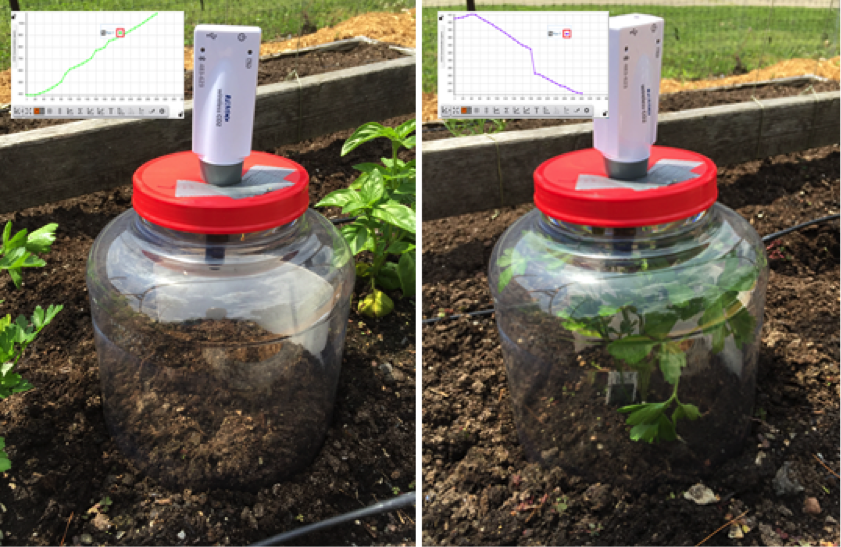Outdoor Explorations in Photosynthesis and Respiration
PASCO’s Wireless CO2 Sensor provides a powerful opportunity for students to explore the effects of photosynthesis and respiration in their local environment. In this blog, we'll explain how students can use a “Pretzel Barrel CO2 Chamber” to design their own experiment and measure the rates of photosynthesis and respiration under a variety of settings and conditions.
Background
Soil plays an important role in the carbon cycle and global climate because it acts as a carbon sink, sequestering CO2 from the atmosphere in the form of organic matter. The upper layers of soil contain organic matter that is actively decomposed by the soil community: microbes, insects, worms, and other animals.
While respiration by soil organisms decomposes organic matter and releases CO2, the plant community is photosynthesizing and taking in CO2 from the atmosphere. Thus, at this part in the earth’s carbon cycle, CO2 is "moving" in two directions – into the atmosphere from soil, and out of the atmosphere into plants. We refer to this transfer of carbon as "CO2 flux." With PASCO’s Wireless CO2 Sensor, students can explore the carbon cycle, plant and soil biology, and climate change by measuring CO2 flux.
The rate of CO2 flux depends on various factors. For soil, the rate of CO2 production may be affected by:
- The content and type of organic matter in the soil
- Temperature
- Moisture
- Sunlight
- Soil chemistry (pH, nutrients, anions, and cations)
For the plant community, the rate of CO2 production may be affected by:
- Type and density of plants
- Temperature
- Moisture
- Sunlight
- Soil chemistry (pH, nutrients, anions, and cations)
Carbon flux will vary with the weather, throughout the day, and throughout the year as the seasons change. Measuring CO2 flux provides an excellent starting point for engaging in NGSS practices regarding the earth’s carbon cycle.

Students can define their own research questions and problems, analyze the results, and generate designs to conduct a variety of controlled experiments using the chamber. Most experiments will identify the CO2 concentration inside the chamber as the dependent variable, allowing students to test the effect(s) of their own independent variables.
On land, students can compare the CO2 flux in soil, lawns, forests, sunny vs. shady areas, and various other locations. In general, when the chamber is on bare soil or leaf litter, the CO2 concentration inside the chamber can be expected to increase, usually within a short period of time, such as 5 or 10 minutes. For longer investigations, the sensor can be placed in Logging Mode (stores data on internal memory) and left for ~24hrs before the batteries are depleted.
Logging Mode Video
The chamber can also be placed over one or more plants. Under these conditions, the concentration of CO2 inside the chamber can be expected to decrease, although it may be counteracted by respiration. The chamber can even float atop water, if wrapped in foam insulation.
In any environment, students can design their own studies to investigate the effect of different variables on CO2 flux.
How to make a Pretzel Barrel CO2 Chamber
The chamber is made of a plastic pretzel container available in supermarkets.
- Draw a straight line around the container. Cut it in half using a razor knife to form two large plastic chambers that are open on the bottom and closed on top.
- Now you have two options: You can cut a hole in the top for the CO2 Sensor using an electric drill or a razor knife. The hole should allow the CO2 Sensor to fit snugly, keeping the container airtight; the hole can be adjusted with tape if necessary to create a tight seal around the sensor. Alternatively, the sensor can be placed inside the container since it’s wireless.
- The chamber is now ready to be used by placing it on top of soil and measuring CO2 flux.
To study aquatic environments, simply wrap a piece of foam pipe insulation around the chamber, or attach a Dissolved CO2 Waterproof Sleeve to the sensor.

